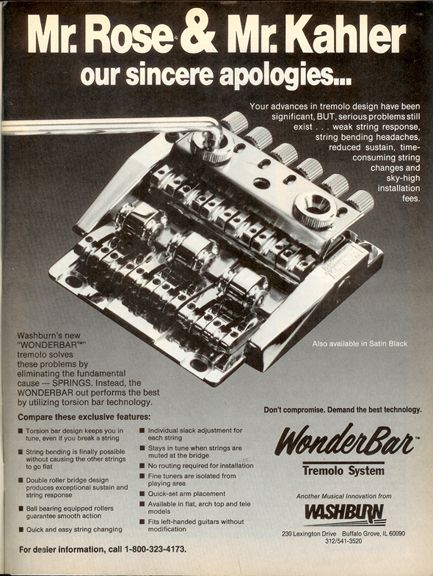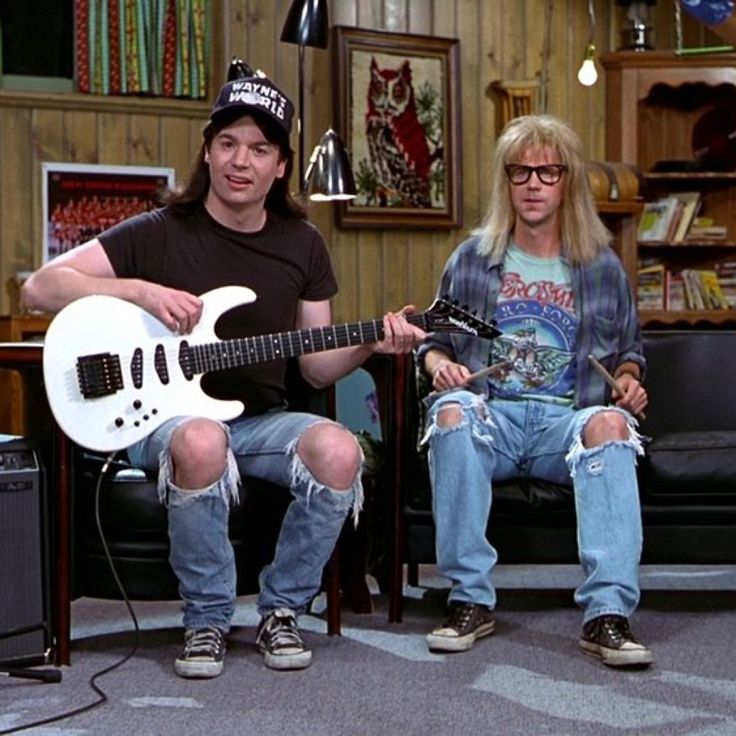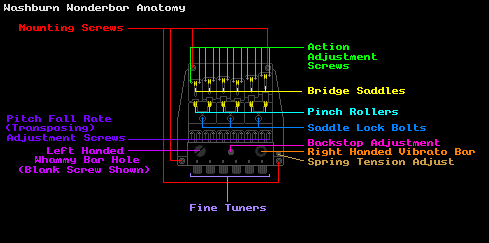

| SHIFT 2001/WASHBURN WONDERBAR The Short Lived, Minimal Damage Alternative to a Kahler or Floyd Rose - with a little "Secret" feature |
||||||||||||||||||||||||||||||||
 The Answer Shift 2001 tremolo system - aka the Washburn Wonderbar - was a quasi-transposing, cammed, vibrato system aimed at being both easy to install with minimal damage to pre-existing guitars. It was released as "The Answer Shift 2001" in 1984, and later was picked up by Washburn guitars and utilized on several models including the Force Series The Answer Shift 2001 tremolo system - aka the Washburn Wonderbar - was a quasi-transposing, cammed, vibrato system aimed at being both easy to install with minimal damage to pre-existing guitars. It was released as "The Answer Shift 2001" in 1984, and later was picked up by Washburn guitars and utilized on several models including the Force Series
The selling points of the unit were that it did not require a router to install, could be retrofitted to almost any sort of guitar without any modification (even to a carved top Gibson using an adapter plate), and they touted the adjustable pitch drop of each string as a feature, but I think they failed (or were working around Steinberger Patents) with their adjustable pitch fall rate system's potential to "tranpose" like a Steinberger TransTrem unit given the right set of strings and some understanding as to how the vibrato worked. As with all things guitar, especially back then, players were mostly pretty conservative in taste, and most younger kids wanted the parts their heroes had (READ: FLOYD ROSE) so it kinda' failed to catch on with the mainstream and eventually fizzled out by some point in the early 1990's. That said it's more often seen on aftermarket installations on guitars than it is on Washburn models. But some people had that bridge. 

It's best known users are Wayne Campbell (Mike Myers), Ace Frehley (yes, from Kiss, who had one put on one of his Les Pauls in the 80's), and I swear I saw Aerosmith or Billy Idol with either Joe Perry or Steve Stevens playing a Hamer Standard with such a vibrato unit (sometime in the 1988-1992 period) also before I learned to play guitar (making me quite confused why your average Stratocaster could not hold a chord in tune during a dive bomb the first time I used one, LOL). 

The vibrato itself is a 3.5"x3.5"x1/2" block of brass and steel that screws to the top of just about any electric guitar with 4 screws. It requires no routing and should retrofit to just about anything as the advertisements in the 1980's said. Functionality 
Possibly the first thing about such a tremolo unit that confuses and weirds out people, is the sheer amount of bolts, nuts, and screws on it for adjustment. See the diagram above.
The vibrato itself is very similar in design to Ned Steinberger's "Trans Trem" designs by function. The baseplate features a separate bridge with a tailpiece attached to the top with a pair of ball bearings and cam-system and quite a wide amount of tuning adjustment at the tailpiece. The tailpiece counteracts the tension of the springs using a torsion spring. The strings pass through the back of the tuning mechanisms, over a cam, under a roller, then over a bridge saddle with a roller on it. The saddles are clamped in place like a Floyd Rose, but unlike a floyd rose, they're pretty easy to adjust without a special tool. That said, it's got to be the most elaborate string path next to the TransTrem. Washburn used this on many of their guitar models including the "Enforcers", G-series guitars (G2-V, G5-V, G-10V) - including the model used by Wayne Campbell (Michael Myers, the actor, not the slasher villan) in the "Wayne's World" Skits and movies. I picked one of these up dirt cheap at a music shop in 2005 and it's been on a few different guitars, eventually finding a home on my home-built "Madrite" Mosrite copy. I was not aware of certian features until years upon years later.The Transposing Feature Explained The Washburn Wonderbar/Shift 2001/The Answer - has a unique feature for an aftermarket vibrato, it can transpose. HOWEVER, there's some caveats to doing this that I've discovered. To understand how this feature works properly on a Steinberger Trans Trem - click that link. The first part of the problem here - and the most important - are the kinds of strings you are using! Steinberger systems use specially calibrated "LaBella", double ball end strings, intended for use with a Steinberger guitar with a Trans Trem. The Washburn Wonderbar assumes it's 1984, and you're going to be using your average regular Ernie Ball/Fender/D'Addario/GHS string sets with it. The string market has gotten massively more complex since the 1980's. Back then, you basically had a bunch of nickel wound string sets in average gauges of .008-.038 to .012-.056 on the market, and they all attached with the same kind of ball ends, had no coatings or special protectants, and roughly, were far more comparable. Nowadays we have crazy stuff like the coated Elixer, Ernie Ball Paradigms, and other strings like that, Cobalt XL, Dean Markley Blue Steel, DR, Fender Bullets, special painted strings for your aesthetic pleasure - and all these alterations in metal formulations, design, coatings, windings, attachment types - affect how these strings will react tuning-wise. In my own experiments - I've tried both Dunlop DEN0942 .009-.042 and Ernie Ball Paradigm Super Slinky .009-.042 gauge strings. Here's my findings.
I have a theory that I've been messing with lateley using the D'addario String Tension Calculator to determine what kind of strings I would want to use on this - in custom sets - to get the fall rates as close as possible - by getting the tension about the same across the board. This is the determination I made - by trying to make every single string pull at somewhere around 13lbs per string. The idea here is that if the strings all pull around the same tension, we can get the drop rate as close as possible - and I think this matches up with what I've seen regarding the "Jowls" on most Steinberger Trans Trem guitars - by looking at the screw positions. The plain "G" String seems the one that has to be set the furthest back to get it to match fall rate, and B & G are pretty close, while the lower three strings are also pretty darned close. Resultant String Set ~ By Tension
What I learned messing with the wonderbar with these string sets, is setting up the "cam" or "jowls" in Steinberger language. These are the six rotating platforms the strings ride over as they pass under the pinch rollers behind the bridge saddles, and their "drop rate" can be adjusted by turning the two very small allen screws on each side. The further up the jowl is set, the faster the string drops in pitch. The strings needing the most (jowl set the highest) will be your highest 3 plain strings. The low E will need it the least. The trick though, is to get a string set where we can get all six strings to have the same fall rate and therefore make the tremolo drop pitch at the right speed. Stuff I Learned about Transposing with a Whammy from Learning how Steinberger's Design Worked The Wonderbar and Trans Trem are really really close. The primary differences are as follows....
What Shift/Washburn Got Right - What Shift/Washburn got right, was the fact you can adjust the fall rate by changing the arc of the strings. And they somewhat made this capability more universal to more strings by using a "V" shaped pull of the strings via pinch rollers behind the bridge saddles - so you can raise the strings up really high in the drop adjustments, and not lose consistant sustain and breakover angle over the saddles (or even have a breakover angle). Also, the wrapping is far enough back there's no stress on it so they don't unravel like Steinberger's Labella's do (whcih is why there are 2 in every pack). What Shift/Washburn Got Wrong - What they failed at with their unit, is compensating the drop mechanisms to be compensated for specific string types. I think this was part of the whole attempt to make a tremolo that would work with regular strings for right and left handed players. This results in only a PARTIAL capability to transpose with regular strings. You can't get the fall rate high enough on the treble end, and the fall rate short enough on the lower end, for them to all meet in the middle. The biggest aggrivator of this issue seems to be strings made by Ernie Ball, particulalry their "Super Slinkies". The best set I used so far, were Jim Dunlop strings, which oddly were the cheapest at $5 a pack, but I got it REALLY Close to staying in tune across all six strings - hence my String Studies above. How to fix This - I think the best best would be to disassemble the Tremolo and see how it goes together, and figure out if a bigger adjustment pawl can be made for the fall rate on the High E and B strings. I think the High E needs a less as deep groove, and the B just slightly less. May also help to make a special set that would work with Ernie Ball strings as well (ie, more height with each one). I might attempt this at some point once my metalworking skills get good enough to make such a part. |